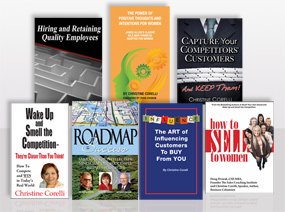
This article has been published in numerous trade publications.
The world has changed! That’s an understatement. No one expected the unprecedented changes that have occured in our world, in business, and in the workplace. The pandemic turned our world upside down.
As a result, companies have had to make changes to ensure survival and success.
In this environment, no business can afford to maintain the Status Quo!
One of the most challenging and important responsibilities for leaders is to institute change. Managerial calls to embrace change are often met with resistance and uncertainty. If not managed correctly, disgruntled employees, profit loss, poor performance, and unacceptable levels of customer service can be the result. Worse, people may simply leave! Employees that have been working from home for the past year or two and are told to go back to the office is a change the majority of employees don’t want to make. Employees leaving their jobs is a harsh reality we must face.
Below are methods to help you manage change, and the transition process.
Communicate the Reason for Change, the Direction, and Goals
Be sure everyone in the organization understands the vision of where the company is going and why. Make them a part of the plan so that they assume ownership. Explain that the change is necessary to remain competitive, be profitable, and maintain a high level of customer care.
Communicate management goals and direction to every level of the company: “I fully understand it’s much different from what you’re used to, but I’m committed to helping everyone adjust to our new system. It will take time to get everyone up to speed, but I’m counting on you to make it happen. Here’s what I need from you…” Then tell them.
Establish an Atmosphere of Open Communication
Open communication is important in every organization at all times, but it becomes even more critical during times of change. As you plan the changes you wish to make, consider developing a concurrent communication strategy to remind people what the changes are, what the expectations are, and the progress you are or are not making in your change efforts.
In a changing environment, people lose their motivation if they are not involved, and kept informed about what is going on around them. Keep in mind that numerous surveys have revealed that many employees feel undervalued, and the less they are informed, the more likely it will have a negative impact on their performance. Your silence may be misinterpreted. With open communication, you help build trust between yourself and your people. Communicate what you know and, as uncomfortable as it sounds, communicate what you don’t know. Failing to address the difficult questions–questions people may already be asking each other and their peers–does not make the issues go away. For example, if you are not sure you will be able to retain every employee say so. They will respect you for your honesty.
Introduce Change Gradually Whenever Possible
Too much change at once can create chaos for yourself and your organization. You may feel your people are ready to respond to change, but they may not be able to absorb the changes as quickly as you like. It takes time to assimilate new information, learn new CRM systems and procedures, or change cultures. Give your people time to understand the changes before introducing more. Many executives and managers agree with this strategy. However, others have stated they prefer a single big macro change rather than several small ones. They feel if everyone learns the game plan all at once, then it’s over and they can get on with it. They contend that disruption continues during the change process whether it is a big one or small ones dragged out over time. You know your people, so think about what would be best for them.
Be sure to keep this in mind: You may be committed to the decisions for change, but others may not have had time to accept the changes let alone understand them. You will have to make sure they understand what your needs and expectations are and help introduce it incrementally if possible. Just remember it’s important to move at a pace that will ensure you meet your business goals and maintain customer care while giving your people the opportunity to process the changes for themselves.
Ask for Accountability
Ask your people to be accountable to each other for maintaining high morale. By placing an equal value on teamwork, professional behavior, performance, and accountability, you will be able to provide better service to both customers and internally. Even if the change or changes you are making are difficult and may need to be introduced incrementally, people still need to be held responsible for making them work.
Be in Tune to Difficulties Some May Be Experiencing
Recognize that most people fear change but it affects each one differently. Some will be more adaptable than others will. While some people enjoy being stretched beyond their present comfort zone, others may be completely insecure. You need to let them know you understand the challenges they are facing and your job as a leader is to help them through it. Be sure to provide adequate training in new products or procedures. Keep your door open so people can come in to discuss any apprehension. You want to provide a comfortable environment where people can air their concerns. It’s normal for people to resist change, so the more patience you show the sooner they will adapt.
Encourage Acceptance and Focus on Positive Opportunities
When people complain about a new system, process, or procedure, you need to acknowledge the difficulty and explain that once they are comfortable with it, their work will become easier.
Communicate to your people they have a choice. They can be either an advocate or a resistor to change, but if everyone does their part, together, you can get through it, and that in the long run, it can be better for all concerned. Help them to see that negativity will only hold everyone back and customer service will be affected. Encourage support, and make them feel a sense of excitement about themselves and your company. If rewards are in the picture, you will see an increase in their level of enthusiasm.
Ask for their input. Give Feedback. Take Action!
Employee involvement is the key to creating high performance through change. Ask your people for their ideas on how you can support each other. This is especially important for those involved in customer care. Many companies are guilty of underutilizing the ideas and suggestions of their front-line and customer service people when going through change and do not take full advantage of their knowledge and experience. If employees are not involved, they won’t feel they are a part of the change; they’ll feel more like victims of change.
Ask how your people are doing. Listen, and encourage cooperation and honesty. Talk to that person who is coming to work with a chip on his or her shoulder. Ask what you can do to help. Encourage upward feedback from everyone on his or her attitudes, concerns, issues, and frustrations that are related to the change.
Encourage Teamwork
Without teamwork, you may run the risk of disharmony within your company. Barriers can develop. In today’s highly competitive business environment, you simply cannot tolerate anyone who works halfheartedly. Without a team culture, some workers may look out for themselves, and not for the betterment of your entire company. Without it, your people can lack the capacity to understand the pressures of decision-makers and managers. While teamwork is challenging for management to instill, especially with budget cuts, downsizing, benefits cuts, reorganization, working from home, and all the other reasons morale may be low, it is vital if the company is to survive.
Be a Role Model
It is up to management to maintain employee morale through change. Set the tone; be a role model and be an example for others to follow. Let people know you are there to help them through it. Be accountable for the attitude that YOU bring to your job each day. Remember this critical key to employee motivation: Make your people feel they are working WITH you, and not FOR you. If they feel they are working for you, they may work like robots that go through the motions of their job and never put their hearts and souls into it, nor show initiative beyond their job descriptions.
Encourage People to Be Solution Focused, Not Problem-focused
“For every problem, there is a solution,” should be a motto in your company. As problems occur during change, under-performers will most likely wait for you to fix them. At the onset, communicate that people will be expected to help identify problems and focus on offering solutions. Changes rarely occur without glitches, so ask them to brainstorm methods to solve the problems. Ask them to find cutting-edge solutions for any customer service problems that may exist.
Alleviate job pressure
Meeting the demands placed upon people during change requires managing job pressure for you and others. As you know, the business climate can be very stressful. In addition to all that is occurring, and what you are striving to accomplish, there is constant pressure. Laugh a little! Change may be serious, but people who have fun at work are more productive and less anxious during change. Encourage an upbeat and fun atmosphere.
You’ve heard the old adage, “The only constant is change.” Yes, change is inevitable, but it doesn’t have to be agonizing. If you make a conscious effort to help our people through change and do your best to ease the transition, you can maintain a high level of customer service and employee satisfaction. Then, you can help them through the next one.


I love the ideas based on business change all are the facts that make business change , in the new millennium we are living today yeah some of us are living more than we expect we are living to our standards not expectations this includes the young people like myself we want everything to happen so fast yet we forget we need to struggle for something in order to get it, it is a challenge to the young people out there who are struggling to make ends meet and the technology we have nowadays has influenced our young people to indulge in many weird activities. lets all help each other with facts, lets be honest to ourselves and lets learn to give good feedbacks to the people around us and finally lets learn to be patient, to sacrifice for the good of not only business but everyone. Christine Corelli is a good role model to many people may God bless her.